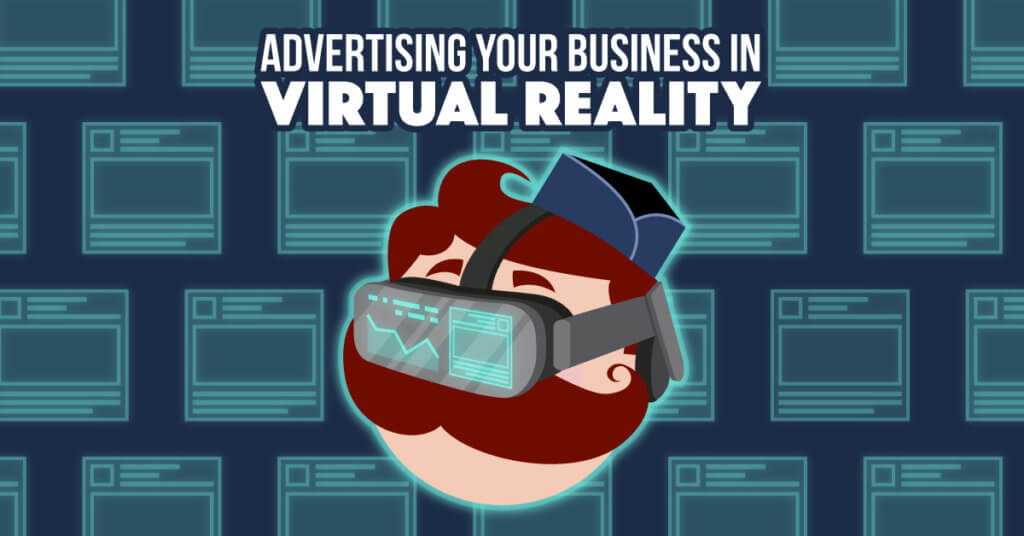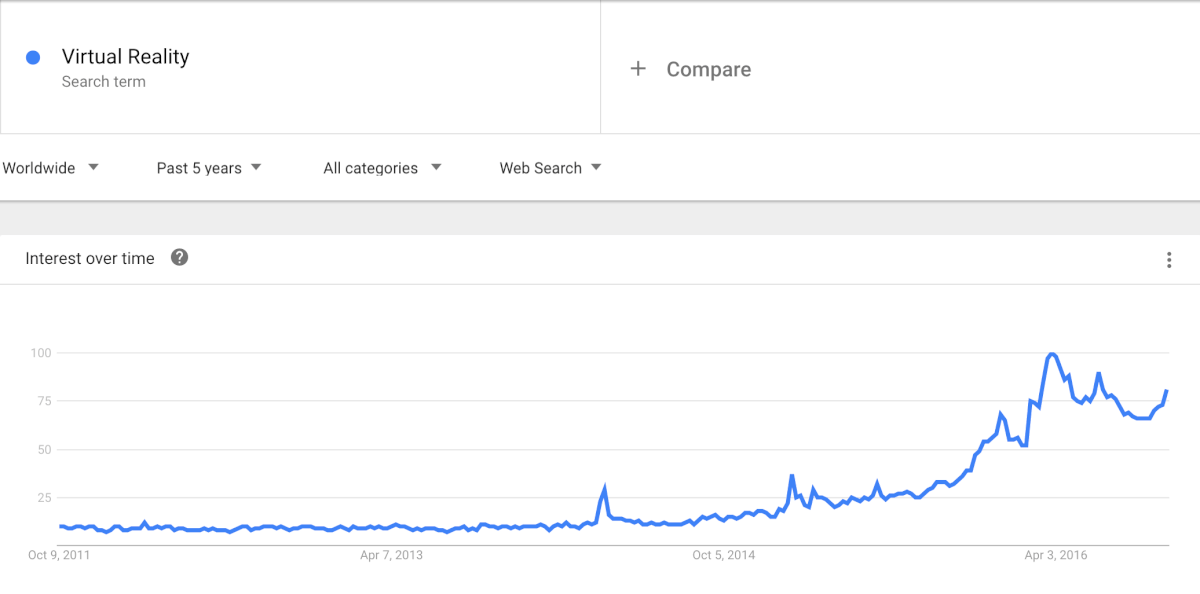
13 Oct Advertising Your Business In Virtual Reality
[ad_1]
Google Data recently revealed a whopping 4X increase in global search interest in virtual reality.
By the end of 2016, it is estimated that there will be more than 12 million VR headset sales and, by 2020, 30 million shipped headsets from the VR industry itself.
Marketers are looking to boost advertisements for brands with the help of virtual reality. With its immersive nature, VR can dramatically bridge the gap between a brand and a user.
In this post, we’ll check out five businesses that are harnessing virtual reality in their ads and how you can create a 360-degree video for your very own VR experience.
It’s safe to say that virtual reality isn’t creeping into our lives anymore; it’s leaping.
 [Source: Google Trends]
[Source: Google Trends]
We’ve seen virtual reality applied to medical procedures, military operations, sports, architecture, journalism and even confronting our deep-set phobias. Now, one more industry exploring the power of virtual reality is advertising.
If you have a VR headset, go grab it and get ready for some great lessons in impactful advertising.
1. Make Your Brand Exciting Like Volvo
Want to experience the thrill of driving a brand new car before even handing the cash over? Volvo removed the car dealer from the equation and used virtual reality to put the viewer in the driver’s seat to let them experience their redesigned XC90 SUV through a scenic route in the country.
Executive Creative Director Jay Zasa wanted to create an experience where “we could put people inside the car without the car physically being there.” By using Google Cardboard as a serious marketing tool, Volvo paired Volvo-branded Cardboards with both Android and iOS apps so that users could play with “Volvo Reality.”
The virtual test drive gives you a full 360 degree look around from the driver’s seat with music in the background. It includes a “Friday Getaway,” which starts in a lush field, then courses through the mountains and comes to an idyllic end by the lakeside.
Takeaway: By adding virtual reality to their marketing, Volvo reached out to people in a more accessible, hassle-free and portable way. Their brand image became more excitable and the audience had a much more immersive and forceful experience with their new ride.
2. Freshen Product Awareness Like Boursin Cheese
Despite being a household name in the United Kingdom, soft cheese supplier Boursin knew that public awareness of its flavors wasn’t exactly high. The brand sought to attract the attention of new generation consumers through experiential marketing.
Enter Boursin Sensorium, winner of the Masters of Marketing award, where the typically uneventful trip to the fridge is given a magical twist. This was the first time a food brand in the UK used virtual reality combined with mobile chairs, wind jets, and actual product samples to give viewers the most vivid experience of the Boursin brand.
The results were solid. Overall awareness of the brand soared to 98% in just two months. Pre-event product usage showed that only 19% of consumers bought the brand regularly or on a monthly basis. Two months later, it doubled to 36%.
Takeaway: Boursin revamped their product’s domestic status by combining virtual reality with live sensory engagement for their audience. Through the attention-absorbing efficacy of virtual reality, it extended itself to a younger generation and ended up winning the hearts of thousands of new customers.
3. Revamp Brand Image Like Coke’s Santa Sleigh Ride
Coca-Cola’s Santa Claus got a makeover in Poland last year. Developers Lemon & Orange took the brand’s annual Christmas truck convoy and gave it a VR twist where you got to be Santa gliding through the wintery skies with your reindeer.
Viewers got to race through beautiful towns adorned in Christmas ornaments, soar over frosty white plains, and glide through bustling highways.
Coca-Cola went one step further to make VR a common experience and shared a short video tutorial explaining the three ways to make recycled cardboard VR goggles with their 12-packs. You can check it out here.
Takeaway: In spite of its veteran status since 1886, Coca-Cola knew how crucial it is to stay current with new-generation consumers. By giving the old commercial imagery of Santa a sharp virtual slant, it demonstrated involvement with its consumers and sustained delectable freshness in its brand.
4. Narrate A Better Story Like Patrón Tequila
The world’s premium tequila distiller doesn’t sound like the first beneficiary of a VR marketing strategy, but Patrón used virtual reality to illustrate the captivating trajectory of their product by transforming viewers into virtual honeybees.
Patrón created a 360-degree journey, with live action and graphics, to show the product’s lifecycle starting from the warm highlands of Mexico to Patrón’s Hacienda Headquarter. The promo video “The Art of Patrón” was shaped by Firstborn, Legend, and Antfood agencies and took six months to complete.
The video was shot with a 360 camera rig installed on a customized flying drone to give viewers a seamless view of the product’s various stages. You can take a sneak peek at the behind-the-scenes video here.
Takeaway: More and more people want to know how the products they consume are made. Instead of ignoring this increasingly common demand, Patrón used the power of storytelling and tapped into consumer curiosity by taking viewers on a detailed and delicious virtual tour of their artisanal tequila.
5. Transport Your Audience Like Marriott’s Teleporter
One industry cozying up to the marketing power of virtual reality is travel. Marriott Hotels decided to use a 4-D tourism experience that teleports viewers to a Marriott Hotel, a beach in Hawaii and a tower in London—without hauling luggage around.
Framestore VR Studio collaborated with Marriott to give the public a taste of touristy teleportation. Viewers got Oculus Rifts, heaters and wind jets to “experience” London and Hawaii.
Although standing inside a phone booth-like structure isn’t exactly the same as physically being on the beach, the 4-D elements of experience—from artificial heat imitating the sun’s warmth to water nozzles for sea spray—helps in influencing a tourist’s decision.
Takeaway: Physically experiencing a foreign destination is the essence of the travel industry. Marriott Hotels took traditional marketing and advertising one step further and gave their audience an actual sensory experience with the help of virtual reality.
Make Your Own 360 Video
One reason why you haven’t seen many 360 videos is because it’s hard to get it right. But things are getting easier. The best way to make a 360 video is by simply experimenting with it. Think of it in three steps.
- Camera: To create a 360 video, you’ll need a compatible camera. YouTube lists three options that range from $200 to $500: Ricoh Theta, Kodak SP360, and IC Real Tech Allie.
- Software and Hosting: Video-stitching software like Kolor Autopano stitches multiple videos into a singular 360 video. With Facebook, YouTube and Wistia supporting 360 video, choosing where to host your video is no longer a problem.
- Experimenting: Finally, play around with your camera and see how it’s different from the usual video.
The fundamental difference between a traditional video and 360 video is that 360 video radically expands the visual frame of a traditional video by going above, below and all around the viewer. Here’s a video by Wistia of their resident pup, Lenny, munching peanuts off the floor in a circle. It’s a sweet and simple concept, but the best part is how easy it is to execute.
It’s Easier Than You Think
At the end of the day, you don’t need prolific agencies or multi-million dollar budgets to create good 360° advertisements. Virtual reality combined with advertising is much more cerebral than cash.
What you need is a sense of innovation and a practical understanding of how virtual reality and 360° video offer an unparalleled and unprecedented opportunity to dynamically change the way you communicate your business.
Now is your chance to apply that understanding to actual video and enthrall your audience.
[ad_2]
Source link
Social Media Agency, Social Media, Digital Marketing, Digital Marketing Agency, Search Engine Marketing, SEO, digital marketing agency dubai, video content marketing, crossfit marketing dubai, video marketing dubai, digital marketing agency abu dhabi, facebook marketing dubai, facebook marketing abu dhabi, digital marketing agencies in dubai, social media agency, content marketing dubai, content strategy dubai, branding dubai

